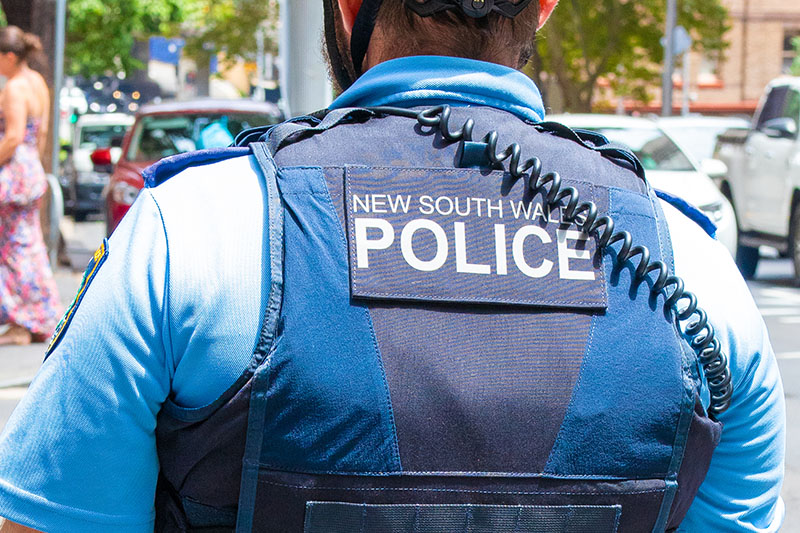It’s a program that allowed police to make home visits at all hours, and stop and search people in the street.
“Unreasonable, unjust, oppressive or improperly discriminatory in its effect on children and young people.”
That’s how the Law Enforcement Conduction Commission (LECC) described a police program that aims to target likely offenders before they commit crimes.
It’s a program that allowed police to make home visits at all hours, and stop and search people in the street.
Last month the Commission released its damning final report after a five-year investigation. Here’s what it found.
Report identifies unlawful practices
The program in question is the Suspect Targeted Management Plan, implemented by New South Wales (NSW) Police.
It’s a pre-emptive policing program that selects and then targets children and adults who police predict may commit crimes in the future.
The rationale behind the policy is to deter recidivists. Once placed on the plan, police “disrupt” people’s everyday lives, through questioning, stop and search, and home visits – sometimes at all hours and even multiple times a week or even a day.
The Law Enforcement Conduct Commission found some of this conduct to be unlawful, possibly even “serious misconduct”.
The Commission concluded that police use of the management plan was an ‘agency maladministration’ but did not make formal findings. This is because NSW Police abandoned the plan before the report was released.
While the plan was introduced in 2000, the then secret ‘black list’ only came to public attention in 2017 with my research (co-authored with Camilla Pandolfini), in partnership with Public Interest Advocacy Centre and the Youth Justice Coalition.
The Commission agreed with our recommendation that there were grounds to investigate the police for potential agency maladministration.
The Commission’s investigation, called Operation Tepito, has been ongoing since 2018. Its interim 2020 report was scathing of police. It recommended further reform of the revised management plan through new policy guidelines and training.
The Commission urged police to engage with young people with “positive interactions” and reduce coercive ones.
The final report reviewed the operation of the plan for children between November 2020 and February 2022. The Commission concluded that police use of the management plan was an “agency maladministration” but did not make formal findings. This is because NSW Police abandoned the plan before the report was released.
First Nations children disproportionately targeted
Of the recommendations the Commission made in 2020, NSW Police failed to successfully implement any of them.
Police overwhelmingly still subjected young people to intrusive, disruptive strategies. Some of these, such as home visits and searches, were unlawful. There was little evidence of “positive interactions”, nor of support referrals.
The NSW Police Force did not undertake any analysis to try to determine the reasons for this and did not take steps to reduce this over-representation.”
The Law Enforcement
Conduct Commission
First Nations young people were disproportionately targeted. In 2022, First Nations people made up 48% of all young people on the plan. This was an increase on the 42% reported in the 2020 interim report.
Crucially, the commission found that: “The NSW Police Force did not undertake any analysis to try to determine the reasons for this and did not take steps to reduce this over-representation.”
First Nations young people are overpoliced, overcharged and overincarcerated. If you then use the same data to decide who is “risky” and deserving of intensified police harassment, it only reinforces the cycle of criminalisation.
The Commission also found other administrative issues, including:
- varied quality in intelligence assessments
- unclear justifications for putting people on the plan
- inflation of how some scores were calculated
- poor record-keeping
- inadequate consideration of complex needs or the alternatives to placing a young person on the Suspect Targeting Management Plan.
A plan at odds with Closing the Gap
The fact NSW Police didn’t implement any of the 2020 recommendations or reduce the over-representation shows the plan was never safe for First Nations young people in the first place.
Indeed, the management plan did precisely what it was designed to do: incapacitate and disrupt.
No amount of training or improvements to policy could remedy the extensive harms for First Nations young people put on the plan. It was fundamentally a punitive surveillance approach, which made police the first responders for First Nations young people.
Police are the wrong people for providing Indigenous young people with non-coercive, therapeutic support. Community alternatives to state policing are real and powerful.
Aboriginal children need culturally appropriate, therapeutic, trauma-informed services run by Aboriginal community-controlled organisations. They also need safe distance from police.
The Suspect Targeting Management Plan was always at odds with the NSW Government’s commitment to divert First Nations people from the criminal justice system.
In its Closing the Gap Implementation Plan, all early interventions to support young people need to be community designed and driven. There should also be health, housing and education support.
A community development approach
NSW Police has dropped the Suspect Targeting Management Plan for people under 18 and will soon scrap it entirely. Police are now developing a replacement approach. Will they take the lead from communities?
The Yuwaya Ngarra-li community-led partnership in Walgett is one example of how holistic diversion programs can work. Another is Just Reinvest in Bourke, Kempsey and Moree.
The UTS Jumbunna Institute of Indigenous Education has developed ideas around Aboriginal self-determination in youth justice that could shape guiding principles.
Police are the wrong people for providing Indigenous young people with non-coercive, therapeutic support. Community alternatives to state policing are real and powerful.
This article first appeared on The Conversation, and is republished under a Creative Commons Licence; you can read the original here.
About the Author
 Dr Vicki Sentas is a Senior Lecturer in Law and Justice at UNSW Sydney, and researches processes of criminalisation and racialisation in law and policing. She teaches in criminal law, criminology and policing, and co-ordinates the Police Powers Clinic, an experiential learning course, in partnership with Redfern Legal Centre. Her recent and current research projects include the effects of counter-terrorism practices, migration controls and multiculturalism policies on criminal justice and racialised peoples in Australia, the UK and the EU; police powers and their relationship to diverse forms of regulation including pre-emption and prosecution; police accountability and criminal justice reform.
Dr Vicki Sentas is a Senior Lecturer in Law and Justice at UNSW Sydney, and researches processes of criminalisation and racialisation in law and policing. She teaches in criminal law, criminology and policing, and co-ordinates the Police Powers Clinic, an experiential learning course, in partnership with Redfern Legal Centre. Her recent and current research projects include the effects of counter-terrorism practices, migration controls and multiculturalism policies on criminal justice and racialised peoples in Australia, the UK and the EU; police powers and their relationship to diverse forms of regulation including pre-emption and prosecution; police accountability and criminal justice reform.
Picture © Ramvespa / Shutterstock


